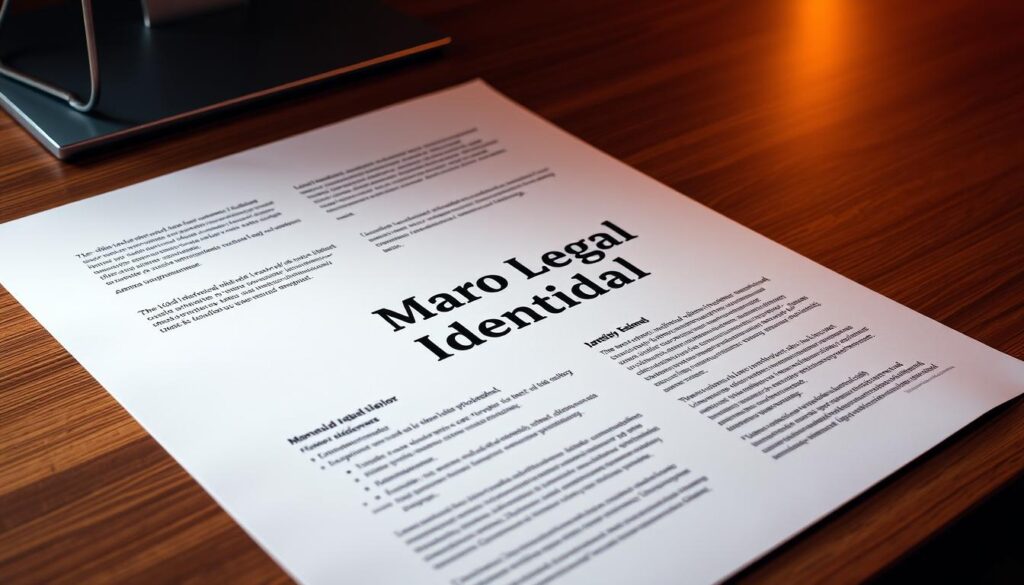Advertisements
Have you noticed strange charges or bills you didn't receive and are wondering if someone is using your name? This is the first sign that usually alerts people when their personal information has been taken without permission.
He digital identity theft This occurs when third parties use your financial or personal information to make purchases, open accounts, or impersonate you. Detecting missing invoices, unexpected charges, or unusual activity on your account allows you to act quickly.
In this article, you'll see clear signs of a data breach and initial steps to take to contain the damage. I'll explain how criminals obtain your name and other data and how they try to monetize it quickly.
In the end you will have simple and practical steps to talk to companies, secure accounts, and use official resources in the United States to report and recover your security.
Key points
- Recognizing suspicious charges and messages helps you react before things get worse.
- Small discrepancies in your credit report are often an early indicator.
- Acting quickly reduces the impact and speeds up recovery.
- There are official resources in the U.S. to report and request help.
- Simple protective measures improve your everyday safety.
Why you're at greater risk today and what it means for your personal information
Massive leaks and the dark web marketplace mean your name is no longer just yours. Large and small companies accumulate data that, after a breach, can end up being sold for little money.
Current context: gaps and the dark web economy
In 2019, there were 1,506 data breaches in the US, with 164.68 million records exposed. Incidents such as Equifax (2017) and Yahoo (2013) showed that names, emails, and even social security numbers can be leaked on a massive scale.
A package called "Collection 1" sold for approximately $45, proving that information is traded and circulates quickly among thieves.
Real impacts: finances, credit, health, and legal matters
With stolen data, someone can open accounts, apply for credit cards, or request utilities in your name. This affects your credit score and can prevent you from getting a rental or employment.
They can also alter medical records or file charges with the police using your name, complicating your legal and health life.
- Financial fraud: new accounts and unknown charges.
- Impersonation: uses in legal proceedings or before authorities.
- Medical risk: medical history contaminated by outside care.
If you want to better understand how this type of crime is committed impersonation And what steps to take as a victim; review official resources and practical guides at prevention and response.
Early warning signs that indicate identity compromise
Sometimes it's small clues that indicate someone used your information. If you notice any of the signs below, act quickly to limit the damage and protect your accounts.
Mysterious charges, unexpected cards, and new accounts
Credit cards Unsolicited notifications or new accounts in your name are a clear red flag. Check your statements and look for small charges: scammers often start with low amounts.
Undelivered invoices, lost mail, and address changes
If you suddenly stop receiving your regular bills, could be Because they changed your address. This allows physical cards and notices to disappear without you noticing.
IRS notices and unknown activity on credit reports
IRS notices regarding duplicate returns or wages you don't recognize require an immediate response. Check your credit reports to detect queries and open lines that you did not authorize.
Collection calls and loan rejections
- Debt collection for other people's debts: ask for written validation and cross-reference it with your report.
- Loan rejections or unexpected checks often indicate attempts to open accounts.
- Check your social networks And email: sometimes they plan impersonation using your network.
Documenta Each clue is documented with screenshots and status updates. These steps facilitate dispute resolution and reporting if the situation escalates and help victims regain safety.
How to confirm if your information was exposed
A quick check of your reports and sessions can reveal if someone has obtained your information. Start by requesting your credit reports from the three agencies at AnnualCreditReport.com and look for unknown accounts, inquiries, or addresses.

Reviewing reports and placing alerts
If you see openings or inquiries that you don't recognize, can be Proof of exposure. Place a fraud alert for one year with Equifax, Experian, or TransUnion; this extent can help curb new applications.
Technical detection: activity on devices and accounts
Review recent activity on emails, banking, and other services. Disconnect any devices you don't recognize and change your passwords. Enable login notifications to see login attempts. line.
Traces on the Dark Web and signals on social media
Use a reputable website for monitoring leaked credentials. social networksLook for cloned profiles, messages sent in your name, or changes in recovery.
"Document everything with date and screenshot; this facilitates disputes and reports to agencies and companies."
- Consider freezing your credit if you need to block the access.
- Audits critical services (banking, tax, health) and confirms recovery methods.
Digital identity theft: immediate steps to contain the damage
A clear plan allows you to contain abuse while regaining control of your accounts. Start by calling the affected issuers and blocking unauthorized charges.
Contact companies and close or freeze compromised accounts
Call the fraud department of each issuing bank. credit cards and the provider where you saw suspicious activity.
Request the closure or freezing of the accountChange passwords and PINs, and request written confirmation.
Set up fraud alerts or credit freezes
Activate an alert fraud Free with Equifax, Experian, or TransUnion. The agency you choose will notify the other two.
Consider a freeze if you want more protectionDownload your free reports at AnnualCreditReport.com.
Report to the Federal Trade Commission
Report the case at IdentityTheft.gov or call 1-877-438-4338. You will receive a Theft Report and a guided plan that can help to your recovery.
Consider filing a complaint with the local police.
If you've been a victim, bring your FTC report, ID, and evidence (receipts, letters). Filing a police report expedites disputes with companies and agencies.
- Call issuers and block charges.
- Activate alert or freeze in all three agencies.
- Report to the Federal Trade Commission and save the plan.
- File a police report if the damage warrants it.
"Acting within the first 24–48 hours greatly increases the likelihood of limiting the damage."
Recovery: How to dispute charges and correct your credit reports
To regain control, initiate formal disputes and close any accounts you don't recognize. Gather statements, screenshots, and emails. Call the fraud department of each business with fraudulent charges and request the removal of the transactions. Use the letter templates from the FTC to close new accounts opened in your name.
Dispute over charges and closure of fraudulent accounts
Identify unauthorized transactions and request a reversal. Ask for confirmation letters proving you are not responsible for the fraud.
- Send letters in writing and keep acknowledgments and case numbers.
- Close or freeze new accounts opened to your name.
- Attach a copy of your ID and the FTC Identity Theft Report.
Blocking and removing inaccurate information from your report
Request the blocking of data derived from heist on your credit reports. Send your Theft Report along with the required documentation to all three agencies.
Monitor activity after each correction and renew alerts or freezes if necessary. If an entity refuses, escalate the case with all your evidence and previous responses.
"Keep each confirmation letter: it will make future clarifications and recovery easier."
Common vectors that identity thieves can use
Understanding how thieves operate It helps you close gaps before suffering losses.
Phishing and fake websites
Emails and SMS Websites that impersonate banks or services try to get you to hand over your credentials. Before entering any information, check the domain, spelling, and see if the layout matches the official site.
Malware, keyloggers and remote access
One click can install software that logs passwords and keystrokes. Keep your devices updated, use antivirus software, and avoid opening suspicious attachments.
Skimming at terminals and gas pumps
Tampered card readers copy credit cards. At gas stations, pay inside the store whenever possible and cover the PIN when entering it.
Public Wi-Fi and traffic spying
Open networks allow your line to be spied on. If you must use public Wi-Fi, activate a VPN and two-step verification to reduce the risk.
Mail theft, garbage diving, and mobile phone use
Collecting mail and shredding statuses prevents the extraction of offers or social security numbers. Protect your phone with a lock and biometrics to prevent unauthorized access via 2FA.
"If you protect passwords, review accounts, and act quickly, you greatly reduce the possibility of identity theft."
- Always verify before entering your SSN or security number.
- Monitor movements and review new names and accounts.
- Use 2FA, password managers, and regularly review your reports.
Special cases: when your Social Security number and your taxes are at stake
When your tax identification number appears linked to returns you don't recognize, act without delay. This type of identity theft occurs when someone uses your TIN (SSN or ITIN) to file taxes and keep the refund.
Tax theft: IRS signs and Form 14039
Clear signs These include IRS notices indicating duplicate returns, balances in years you did not report, or W-2s from unknown employers.
If that happens, immediately file the IRS Identity Theft Affidavit (Form 14039).
Useful contact: The IRS Identity Protection Unit is available at 1-800-908-4990 to guide you step by step.
Child ID theft and how to detect it
The abuse of a child's identity can be silent and appear years later. If a child appears in credit reports or has debts, there are indications of misuse.
- Review periodic reports and place alerts or freezes if eligible.
- Safeguard documents from social security and avoid sharing your TIN by phone or email.
- Keep copies of all communications with the IRS; they will be useful if you are victimized again.
"If the refund was diverted, the IRS will redirect the funds after verification; the process requires patience and follow-up."
Practical prevention: strengthen your passwords, devices, and accounts
Small changes to your daily routine can block attempts to use your personal information. Start by reinforcing the basics: unique passwords, good device practices, and control over what you share online.
Passwords, 2FA and managers
Use passwords long and unique for each service. A password manager makes it easy to create and manage them without repeating them, which can help to prevent attackers from using leaked information.
Enable 2FA with an authenticator app whenever possible; this limits the access even if someone knows your password.
Device updates and locking
Keep your systems and apps up to date. Patching measures close vulnerabilities that identity thieves often exploit.
Lock your devices with a PIN or biometrics and disable on-screen notifications to protect sensitive information.
Minimize data on social media and opt out of offers
- Limit what you post on social networks And check your privacy settings: don't share your phone number or date of birth.
- Shred documents with data and use digital wallets to pay contactless.
- Request an opt-out from credit and insurance offers at 888-567-8688 or www.optoutprescreen.com to reduce the risk of fraud.
"Review your reports twice a year and get your free reports at AnnualCreditReport.com."
Scheduling regular checks helps you detect any signs of impersonation early and protect your security financial.
Legal framework and resources in the United States that can help you
Knowing the law and public resources gives you an advantage How to react when someone uses your name without authorization. Here you'll see what rules apply and where to get help online.

Federal law and the role of the Federal Trade Commission
18 USC 1028 It criminalizes the unauthorized use of another person's means of identification to commit fraud or crimes. This protects you when you report to federal authorities.
The Federal Trade Commission It coordinates assistance for victims and offers sample letters and practical steps for disputes.
IdentityTheft.gov, free reports and freezing
IdentityTheft.gov It centralizes the process: it assigns you a plan, generates documents, and explains how to obtain your credit reports free at AnnualCreditReport.com.
You can request a freeze to limit the access to your file and reduce attempts to open accounts or use credit cards.
Lessons from major incidents
- Yahoo (2013) and Equifax (2017) showed that even large companies They fail and expose millions of accounts.
- The "Collection 1" package, sold for approximately $45 USD, revealed the scale of the trade. information.
- Learning from these cases helps you prioritize accounts and services after a breach.
"If an entity refuses to correct, keep all case numbers and escalate the dispute to regulators; the regulations are on your side."
Conclusion
Detect unexpected activity—such as missing invoices, strange charges, or unknown inquiries— could be the difference between a scare and a long process.
If you have been a victim, follow the measures basics: report to IdentityTheft.gov, request alerts or freezes with Equifax, Experian, and TransUnion, and dispute charges to block inaccurate information.
Strengthen your protection With 2FA, strong passwords, and frequent account reviews, each person reduces their exposure by limiting what they share and keeping their records organized.
Act within the first 24–48 hours It will help you recover your identity faster and regain control of your name and accounts.
FAQ
What are the most common signs that your personal information may have been compromised?
You might see unfamiliar charges on your credit cards, accounts opened in your name, bills that don't arrive, address changes, or lost mail. You'll also receive notices from the IRS, collection calls for debts that aren't yours, and unexpected credit application rejections.
Why are you at greater risk today, and what does that mean for your information?
Massive data breaches and the dark web economy make it easy for personal data to circulate and be sold. This increases the likelihood that someone will use your name, Social Security number, or accounts to commit financial fraud, open credit cards, or access online services.
How do you detect mysterious charges or credit cards opened without your consent?
Regularly review your bank statements and credit reports. Look for small or recurring transactions and any new cards or accounts. If anything seems suspicious, contact the card issuer and request an immediate investigation.
What to do if you don't receive important bills or notice changes of address?
Verify your addresses on key accounts (bank, utilities, post office). Contact the affected companies and update your passwords. Consider alerting the post office and reviewing your address history for unauthorized redirects.
How do you confirm if your information was actually exposed online or on the Dark Web?
Use identity monitoring services and search breach verification tools like Have I Been Pwned. Review unusual activity on devices and online accounts, and request credit reports to see any new inquiries or accounts.
What immediate steps should you take if you confirm an exposure?
Contact the affected businesses to close or block accounts, change passwords, and enable two-factor authentication (2FA). Set up fraud alerts or freeze your credit with Equifax, Experian, and TransUnion. Report the incident at IdentityTheft.gov and consider filing a police report.
How do you place a fraud alert or freeze your credit with agencies?
Request a fraud alert or freeze directly on the Equifax, Experian, and TransUnion websites. A freeze prevents new accounts until you lift it; a fraud alert requires lenders to verify your identity before approving credit.
Should I report to the Federal Trade Commission (FTC) and IdentityTheft.gov?
Yes. IdentityTheft.gov guides you through creating a recovery plan and generates reports and letters you can use with banks, agencies, and employers. The FTC collects data that helps respond to large-scale incidents.
When is it necessary to file a complaint with the local police?
File a complaint if you experience significant financial losses, fraudulent use of your Social Security number, or if an entity requests it to ensure investigations and reimbursements. The complaint serves as an official document for claims.
How to dispute charges and correct errors on your credit report?
Contact creditors to dispute charges and request evidence. Send formal letters to credit bureaus detailing errors and attach supporting documentation. If the bureaus don't correct the errors, use the IdentityTheft.gov report and available legal resources.
What methods do thieves use to obtain personal data?
They use phishing and fake websites, malware and keyloggers, skimming at points of sale and gas stations, unsecured public Wi-Fi networks, email theft and "junk diving", and phone theft with 2FA abuse.
How do you detect malicious activity on your devices and accounts?
Watch for unusual behavior: unexplained logouts, unsolicited verification messages, new apps, unusual data usage, or pop-up windows. Run antivirus software, check app permissions, and change passwords if you see any suspicious signs.
What to do if your Social Security number was compromised or your tax identification was used?
Report tax fraud to the IRS and consider filing Form 14039 if you suspect misuse of your Social Security number. Request a Tax Protection PIN from the IRS and review your tax returns and related transactions.
What practical steps can you take to prevent future incidents?
Use unique passwords with a password manager, enable 2FA, keep your systems and antivirus software up to date, minimize the information you share on social media, and opt out of credit offers. Monitor your credit reports regularly.
What legal resources and organizations in the U.S. can help you?
The FTC offers guides and tools at IdentityTheft.gov. The three credit bureaus allow for account freezes and disputes. Federal laws such as 18 USC 1028 penalize identity fraud, and major breaches like those at Yahoo and Equifax demonstrate the need for ongoing vigilance.



